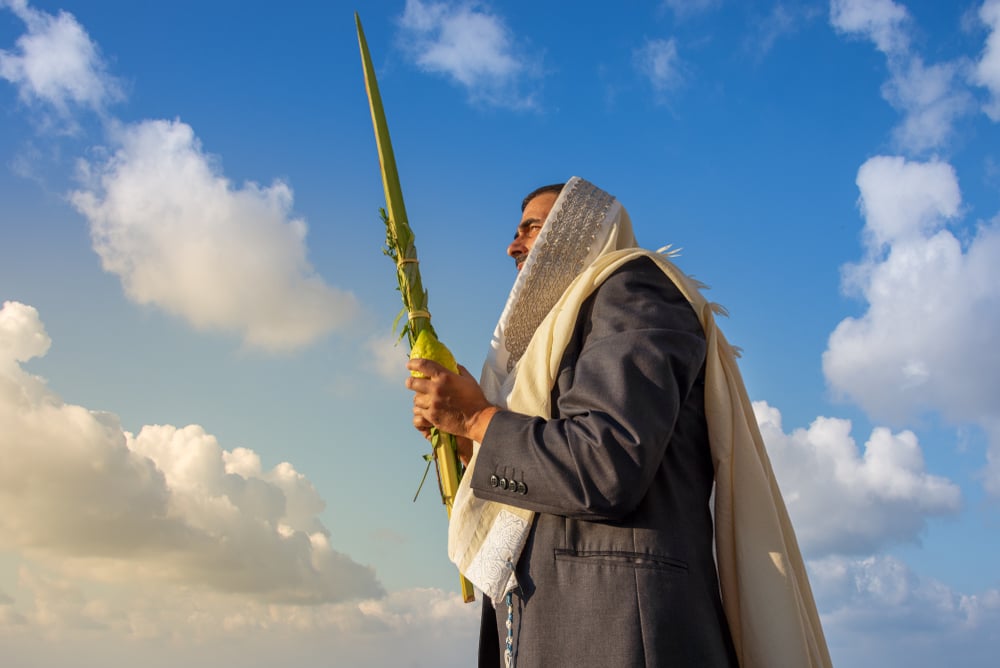Jews have a very strange custom to take four species (Heb. arba’a minim)—a fruit of a citron tree (etrog), a branch of a date palm (lulav), boughs from the myrtle tree (chadassim), and branches of the willow tree (aravot)—and wave them in all six directions (na’anuim) while holding the species together. The precise movements involve bringing the bunch to one’s heart, then moving them to and fro in all six directions, three in each direction, every time returning the bunch to the heart. A strange sight indeed… what could it possibly mean?
I’ve written before that Sukkot has to do with bringing holiness into time and space. The seven days of dwelling in the sukkah-booth (a.k.a. tabernacle) is related to the most important cycle of time – 7: there are seven days in a week, seven years in a Sabbatical cycle (shemita), seven Sabbatical cycles in a Jubilee (Yovel), seven millennia in cosmic Sabbatical cycles, etc. and it all comes from the seven divine emanations (midot—seven lower sefirot from Ḥesed to Malḥut) of the world of Atzilut known in the Kabbalah as the Order of Times (seder ha-zemanim).
But more than that, the holiday of Sukkot is related to the concept of space. We dwell during this holiday in make-shift booths having six sides hinting at the six directions in a three-dimensional space. We wave the four species (arba’a minim) in six directions.
But why do we move these plants to and fro, back and forth, three times in each direction? I suggest the following explanation.
As Aristotle already noted, time is the rate of change. The Sages of Kabbalah agree—time, in its essence, is change. Space, on the other hand, is static. It symbolizes constancy, the lack of change. Mass (and the energy that is proportionate to mass: E=mc2), is a measure of the resistance to change. It’s all about change. The concept of change comes from the initial impetus to create the world—mati velo mati—“touching and not touching.” G‑d, as it were, touching this world and not touching, remaining aloof. He is the Creator; He fills the world; and yet, He is kadosh, i.e., removed from the world, utterly transcending it. This rhythm translates into a reciprocal rhythm of ratzo vashov—“running and returning,” as Ezekiel observed in his prophecy Ma’aseh Merkavah. Ratzo vashov is the breathing rhythm of the universe setting off the flow of time—the time-flux.
One of the cardinal concepts of Jewish mysticism, Kabbalah, is the concept of light (ohr) and vessels (kli or pl. kelim). Light is a metaphor for G‑dly emanation. Simple light (ohr) enters the vessel (kli), which gives the light its “color,” i.e., its specific property. Light (the emanation) represents change and, consequently, time. Vessels, which are fixed and unchanging, represent static space. Light entering the vessels metaphorically represents time “entering” space, i.e., uniting with space.
A mystical intention (kabbalistic kavanah) of shaking lulav and etrog (the four species—arba’a minim) is to infuse vessels with G‑dly light. It strikes me that another meaning of these movements may be to infuse time into space. As I mentioned above, mass (energy) is a measure of resistance to change. Perhaps this is why it takes us to extend our energy in moving lulav and etrog to and fro, as in ratzo vashov—running and returning, to overcome the resistance to change and effectuate this unification of time and space. Why three times in each direction? Perhaps, because time is comprised of three categories—past, present, and future—which we represent by three to and from movements in each direction.
Einstein and Minkowski attempted to unify time and space in a four-dimensional spacetime continuum called the Minkowski spacetime. In the process, they lost the time-flux. This gave rise to the block theory of time, in which there is no time-flux, and the flow of time is an illusion. On Sukkot, we try to remedy this by moving the four species in each direction to reset the flow of time.


Profound. Will subscribe…
I appreciate your wisdom which Hashem bestowed upon you, I believe I will partake of your knowledge in regards spirituality, my regards Benjamin
Very interesting interpretation. Reminds me that in his Maamar from Sukkot 5738, the Lubavitcher Rebbe spoke about the uniqueness of space in Sukkot – all Hagim are holy in *time*, but Sukkot also in *space*, and it’s the combination that’s special (see there).